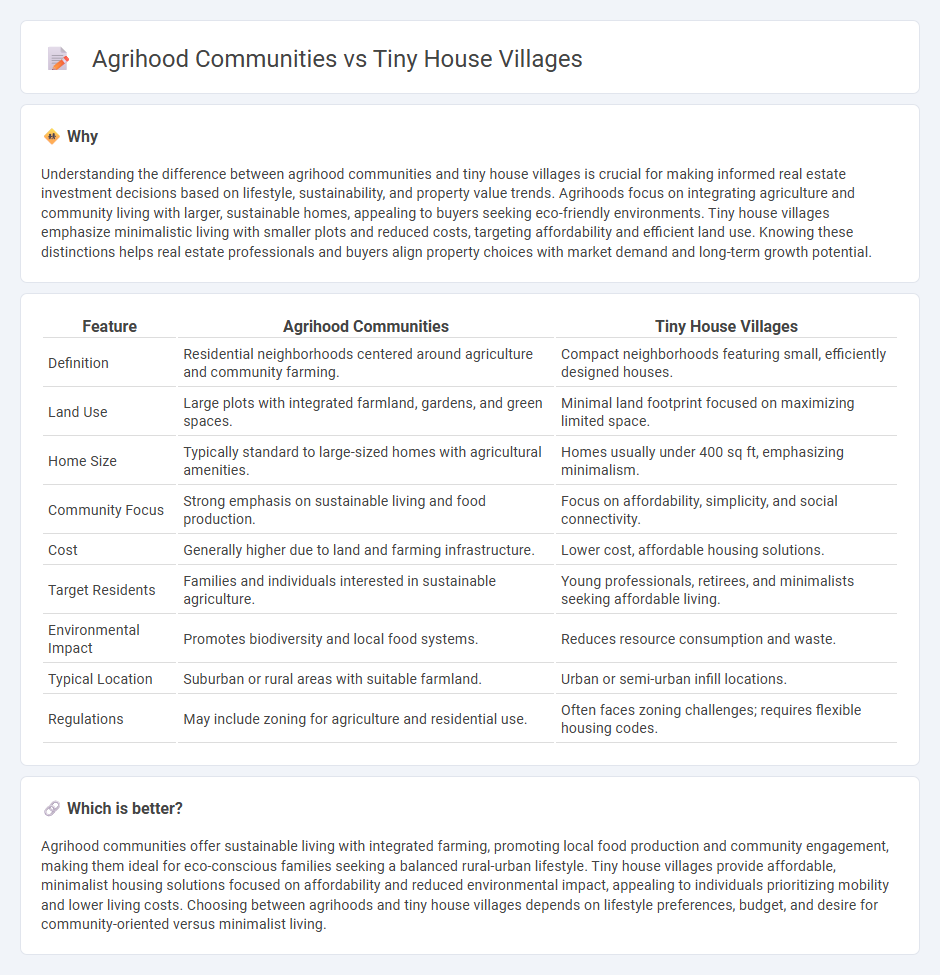
Agrihood communities integrate sustainable agriculture with residential living, offering residents access to fresh, locally grown food and fostering a strong sense of community around shared green spaces and farming activities. Tiny house villages focus on compact, affordable living solutions that maximize space efficiency and promote minimalist lifestyles, often appealing to those seeking financial freedom and environmental sustainability. Explore how these two innovative residential models are transforming real estate trends and lifestyle choices.
Why it is important
Understanding the difference between agrihood communities and tiny house villages is crucial for making informed real estate investment decisions based on lifestyle, sustainability, and property value trends. Agrihoods focus on integrating agriculture and community living with larger, sustainable homes, appealing to buyers seeking eco-friendly environments. Tiny house villages emphasize minimalistic living with smaller plots and reduced costs, targeting affordability and efficient land use. Knowing these distinctions helps real estate professionals and buyers align property choices with market demand and long-term growth potential.
Comparison Table
| Feature | Agrihood Communities | Tiny House Villages |
|---|---|---|
| Definition | Residential neighborhoods centered around agriculture and community farming. | Compact neighborhoods featuring small, efficiently designed houses. |
| Land Use | Large plots with integrated farmland, gardens, and green spaces. | Minimal land footprint focused on maximizing limited space. |
| Home Size | Typically standard to large-sized homes with agricultural amenities. | Homes usually under 400 sq ft, emphasizing minimalism. |
| Community Focus | Strong emphasis on sustainable living and food production. | Focus on affordability, simplicity, and social connectivity. |
| Cost | Generally higher due to land and farming infrastructure. | Lower cost, affordable housing solutions. |
| Target Residents | Families and individuals interested in sustainable agriculture. | Young professionals, retirees, and minimalists seeking affordable living. |
| Environmental Impact | Promotes biodiversity and local food systems. | Reduces resource consumption and waste. |
| Typical Location | Suburban or rural areas with suitable farmland. | Urban or semi-urban infill locations. |
| Regulations | May include zoning for agriculture and residential use. | Often faces zoning challenges; requires flexible housing codes. |
Which is better?
Agrihood communities offer sustainable living with integrated farming, promoting local food production and community engagement, making them ideal for eco-conscious families seeking a balanced rural-urban lifestyle. Tiny house villages provide affordable, minimalist housing solutions focused on affordability and reduced environmental impact, appealing to individuals prioritizing mobility and lower living costs. Choosing between agrihoods and tiny house villages depends on lifestyle preferences, budget, and desire for community-oriented versus minimalist living.
Connection
Agrihood communities and tiny house villages both emphasize sustainable living by integrating residential spaces with agricultural practices and minimalistic housing. These developments foster tight-knit communities that prioritize local food production, environmental stewardship, and affordable, space-efficient homes. By combining shared green spaces and urban farming with compact living, they promote eco-friendly lifestyles and social interaction among residents.
Key Terms
**Tiny House Villages:**
Tiny house villages offer compact, affordable living spaces designed for minimalistic lifestyles, often fostering strong community bonds through shared amenities and common areas. These villages prioritize sustainability and efficient land use, appealing to individuals seeking environmentally conscious housing solutions. Explore more about how tiny house villages can transform urban living and promote sustainable communities.
Zoning Regulations
Zoning regulations for tiny house villages typically involve restrictions on minimum dwelling sizes, lot coverage, and utility connections, posing challenges for sustainable development. Agrihood communities often benefit from agricultural zoning that allows integration of farming activities, residential units, and community spaces, promoting ecological and social sustainability. Explore detailed zoning frameworks and legal considerations to understand the development potential of these innovative living solutions.
Communal Amenities
Tiny house villages emphasize shared amenities such as communal kitchens, co-working spaces, and gardens that foster close-knit social interaction and sustainable living. Agrihood communities integrate agricultural features like community farms, edible landscapes, and farmers' markets, promoting farm-to-table lifestyles and environmental stewardship. Explore how these distinct communal amenities shape community engagement and lifestyle choices in both living models.
Source and External Links
15 Charming Tiny House Communities - Bob Vila - Features various tiny house villages like New Mexico's Tiny Home Village for unhoused people, San Diego's mountain-community Tiny House Block, and Ohio's Cedar Springs Tiny Village with amenities and rental options.
Discover Tiny Home Communities In The USA [Bookmark This] - Highlights tiny home villages such as Lake Dallas Tiny Home Village in Texas with community gardens and essential services, and County Line Cottages, a 55+ senior community in Texas Hill Country, focused on peaceful rural living.
Tiny House Communities - Describes Escalante Village in Durango, Colorado, as an affordable riverfront tiny home community blending urban convenience with outdoor recreation and customizable homes.
 dowidth.com
dowidth.com